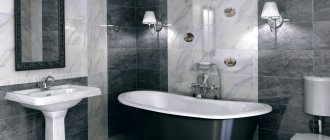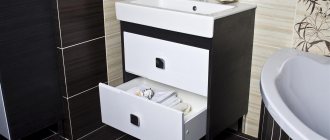A bathroom sink is an indispensable attribute in any apartment.
Unfortunately, not all apartment buildings can boast large baths. In old buildings, especially with a separate bathroom, there is critically little space in this room. In turn, this leads to the fact that many homeowners refuse to install a bathtub, replacing it with a shower stall, or refuse to place furniture or a washing machine. The size of washbasins is incomparably smaller than the size of the bathtub or washing machine itself, and therefore, as a rule, there is always a place for it. Indeed, it is somewhat inconvenient to brush your teeth and clean yourself up every morning and evening, or wash your hands during the day, without a washbasin. Based on this, during any renovation in the bathroom, special attention is paid to the sink. Nowadays there is a huge selection of all kinds of bathroom sink models available in stores from different manufacturers, made from different materials and having different shapes. They also differ in the methods of fastening. Some models are installed on a cabinet, others can be hung on the wall in any convenient place.
Features of choosing a sink
Before purchasing a sink, you need to take certain measurements. To do this, you will need a regular tape measure, with which you can simply measure the bathroom. Based on the data obtained, a drawing is made indicating the location of all items for the bathroom. In addition, the plan must indicate the dimensions of the plumbing fixtures. This will make it possible to determine how much free space will remain in the room, which directly determines the ease of use of the room.
In addition to the anthropometric data of the people living in the apartment, the specifics of the use of the bathroom are also taken into account. So, in order to be able to get as close as possible to the bathtub, there should be a footrest next to it. The same applies to the specifics of placing the device on an additional stand, or hanging from the wall. It is also necessary to take care of the convenience of cleaning, which requires more space than in normal cases. Armed with all this data, figuring out the appropriate size of the sink for your bathroom is much easier.
What to look for when buying a sink?
The first step in choosing a suitable sink is measurements. Armed with a tape measure, you should carefully measure your own bathroom. Then a sketch plan is drawn up, which reflects the position of all the plumbing for the bathroom.
On such a plan, you should note the dimensions of all items installed in the bathroom. After this, you can calculate the size of the free space that will remain for visitors.
A cabinet is almost always installed under a wide sink. To make cleaning the bathroom more convenient, you should give preference to a wall-mounted model.
It is important to take into account not only the height and build of bath visitors, but also the peculiarities of using the bathroom. For example, to stand close to the bathtub, you will need a small space for your feet below. The same point can be significant when using a washbasin located above the washing machine or on the cabinet.
The housewife who has to do the cleaning will need more space than the average visitor. All these small nuances will allow you to make the right decision regarding the size of the washbasin and its location in the bathroom.
Types of shells by size
The following classification is used according to the size of washbasins in the bathroom:
- Mini sinks
. Small-sized sinks that are used to equip bathrooms or toilets. - Standard
. They have the usual parameters and configuration. - Combined
. Here the paired device is located on a stand. There are also other combinations. - Non-standard
. Made to order only. Typically used for furnishing bathrooms decorated in a creative style.
When deciding on a bathroom sink, you need to pay attention to its height, depth and width. Too large a washbasin for a bathroom is fraught with cluttering of space, of which there is usually not very much there. An excessively small sink is also not always the right solution: its small depth or width can cause splashes to fly in all directions while washing. As a result, the need to clean the room will arise much more often.
A trip to the store should be prepared: in addition to drawing up a diagram of the bathroom, you need to take a tape measure with you to personally check the sizes of all the options you like. The fact is that the information in the product description is not always correct, and returning a product with inappropriate parameters is quite a troublesome task. This is especially true when it comes to small bathrooms.
Which sinks are the most practical for use in the kitchen?
The most practical round sinks are with a diameter of 600 mm, but if the dimensions of the kitchen do not allow the installation of such equipment, and the family is large, then a sink with a diameter of 450 mm and a depth of 200 mm is suitable.
If you have a dishwasher, you can install a narrow sink no more than 300 mm in diameter. If the sink will be placed in a corner, and the dimensions of the kitchen allow you to install a large sink, then it is better to install multi-section trapezoidal equipment with a pull-out mixer.
For sinks with a depth of up to 160 mm, you should choose a tall L-shaped mixer, and for greater depths, with a higher spout.
Width selection
As experts say, the optimal width of a washbasin in a bathroom is 50-65 cm. Too wide products are not appropriate in ordinary bathrooms, taking up too much space. Especially if only 1-2 people live in the apartment. However, if the bathroom is large, then the sink should be appropriate. This will allow it to fit into the overall design of the room. In a small room, it is better to place a compact sink with a width of 30 cm. As a rule, products of this type are traditionally used in offices: such miniature products are installed very rarely at home. They are too inconvenient to use. The width of the product directly affects what the mounting platform for the mixer will be.
Recently, double sinks have been in high demand. As a rule, large families buy them, which simplifies getting ready for work/school in the morning. Products of this type allow two people to wash and brush their teeth at the same time. The dimensions of sinks in a bathroom of this type should be such that the distance between the centers of the washbasins exceeds 90 cm. Only in this case the use of a double washbasin will not cause inconvenience.
It is extremely important to place the faucets correctly in such models: it is better if they are installed not in the center of each washbasin, but nearby. In this case, the spouts are turned at right angles to the adjacent element. As a result, they will be located at an angle of 45 degrees to the wall.
Manufacturers
The following companies are included in the ranking of the best kitchen sink manufacturers:
- Blanco - for durability;
- Alveus – for the variety of models;
- Franke – for resistance to temperature changes;
- GranFest – for the color scheme;
- Omoikiri – for capacity;
- ZorG - for strength and sound insulation;
- Melana – for the price of the assortment;
- TeKa – for quality.
In any kitchen you can choose a sink that will be convenient and fit perfectly into the interior. If necessary, you can supplement the sink with accessories.
Depth selection
As practice has shown, washbasins with a depth of 48-61 cm are considered the most convenient. When deciding on this parameter for your sink, you start from the average arm length of family members. To do this, simply extend your hand over the sink. The result is considered normal if the opposite cut of the cup ends in the middle of the palm or opposite the fingers.
The depth of the washbasin bowl is also extremely important: the size of the bathroom washbasin determines whether the water flowing from the faucet will splash. An excellent solution in this regard are the “tulip” and “half-tulip” models.
Height
This parameter for the bathroom sink can be set at your discretion. This primarily applies to wall-mounted models, which are attached to the rear wall of the room during installation. Although it is generally accepted that the optimal height for a washbasin is 80-85 cm, in practice the height of the sink from the floor is determined by location, depending on the preferences of the residents.
The dimensions of bathroom sinks with a cabinet are fixed, so these popular models must be purchased very carefully. The fact is that washing machines are often placed under such washbasins, the height of which must be taken into account in advance (read: “How to install a sink above a washing machine - detailed instructions”). The aspect of convenience is also important. So, for men, the best height of a cabinet with a sink is considered to be 94-102 cm, for women - 82-93 cm.
Classification of bathroom sinks by width
One of the most important parameters of a washbasin is its width: it is this that affects the depth of different models. It should be noted that the depth range of the products on sale is not so wide. The dimensions of a bathroom sink with cabinet, pedestal and other stands are static and cannot be changed. Wall-mounted models are more diverse in this regard.
What are the different widths of bathroom sinks:
- 30-40 cm
. Minimalist corner models most often have similar dimensions. Small bathrooms are usually equipped with such products. If you need to install a hand washing device in a separate toilet, then use this particular washbasin. Such solutions are often found in large families, where the bathroom is often occupied. Miniature sinks are sometimes equipped with wall-mounted cabinets of suitable parameters. Inside the stand you can store household chemicals and cleaning equipment. Such stands can be made to order. - 50 cm
. The most popular option for small and medium-sized bathrooms. They are much more convenient to use than previous models. The wall-hung version of this sink is considered the most compact and convenient. In cases where the furnishings of the room allow it, you can use a bathroom sink with a cabinet, the dimensions of which are selected individually. Similar models are available for sale in a wide variety. In addition to wall-mounted varieties, built-in, round, asymmetrical, oval and other models are offered. - 60 cm
. Sinks of this width are usually used in spacious bathrooms and combined bathrooms. If there is enough space, there is always a desire to fill it usefully. Large corner sinks look very nice. They are distinguished by ease of use, with a fairly compact placement.
The height of the cabinet with a bathroom sink should be such that it is enough to accommodate communications. There is also room for several shelves or drawers for household chemicals and other practical things. At the same time, the room will be beautiful and neat. On the other hand, various dirt often accumulates under the cabinet. Wall-mounted sink models are more practical in this regard.
As for products with a width of 90 cm, they are intended for large bathrooms and bathrooms. Only double washbasins surpass them in width. If there is enough space for such large plumbing fixtures, then they try to install it on large cabinets. Some dimensional samples have a width of up to 150 cm.
What types of kitchen sinks are there: types of kitchen sinks
Sinks differ in the following parameters:
- configuration;
- dimensions;
- material;
- capacity;
- wear resistance;
- color and style.
At the same time, if the owners did not hire an interior designer during the renovation process, then it is better to wait when choosing a sink. In the final result, with a combination of colors and style, all the shortcomings will be visible.
Best kitchen sinks by size
The sink is installed leaving at least 50 mm around the perimeter or circumference. But the optimal depth of a household sink is 170-210 mm. However, a middle ground is found so that a convenient location allows you to wash baking sheets and large pots without difficulty. Sinks are available in several configurations with different parameters, some of the popular ones include the following:
- square with a side of 500 or 600 mm;
- rectangular – 400*600 mm, 500*(600, 800, 1000, 1250 mm);
- corner with sides 500*550 mm, 500*800 mm, or 500*1000 mm;
- round – diameter 450-510 mm, in rare cases 300 mm;
- oval – length 560-780 mm and width 44-510 mm;
- trapezoidal – 780*500 mm;
- with a sink depth of 160-210 mm.
Standard sizes
Today there are a number of standard sink sizes:
- for square-shaped equipment – 500*500 mm or 600*600 mm;
- for rectangular sinks – 480*850 mm, 500*770 mm, 440*780 mm or 510*580 mm;
- for round sinks – 450-510 mm.
The biggest
Large sinks are very practical and comfortable to use, meaning you can wash large dishes or clean a large number of plates in a short time. They are more reliable and durable, since they are resistant to sudden temperature changes and the effects of household chemicals, and are characterized by increased impact strength.
In addition, they are very easy to care for and do not change their original appearance for a long time. The most spacious large sink is considered to be a round-shaped product. If, first of all, preference is given to the functional purpose, then it is better to choose a large sink with several bowls.
Narrow
Narrow sinks take their place in small kitchens, where it is simply not possible to place large or standard sink models. Their width is no more than 300 mm. However, in terms of comfort they are not inferior to even the largest models. They are spacious, resistant to temperature changes, mechanical and chemical damage. In addition, they have an attractive appearance and can fit into any interior style and look harmonious regardless of the installation method.
Smallest - width
This parameter depends on the free area of the countertop. In small kitchens, round, square or trapezoidal sinks are most often installed; in rare cases, they are replaced with corner ones. If the housewife often needs to wash baking trays and large pots, then narrow sinks are installed in small kitchen spaces. Its only disadvantage is that due to its small width, it does not have space for drying dishes, so you need to allocate space on the countertop or make hanging shelves.
Appearance and shape
When choosing a kitchen sink, shape and appearance are the main factors. The shape of the selected sink depends on:
- kitchen dimensions;
- individual requirements;
- style concept.
Some sink models have a “wing” (a flat part that rests on the surface of the countertop). For a left-hander, the wing should be on the left side, for a right-hander - on the right.
Round sinks are considered the most convenient to use, however, while maintaining a clear interior style, they often choose awkward or bizarre shapes for kitchen sinks.
Material used
Practical Soviet sinks have been supplanted by numerous modern models, and no less durable. The choice of material when selecting a kitchen sink is determined by:
- individual wishes;
- style of the room;
- financial capabilities.
Today, copper, stainless steel, metal, stone or acrylic chips are used for production. Plastic derivatives are used less frequently.
Exterior design
Among the stylish sanitary ware, there are beautiful designer types of washbasins. Although they seem convenient, practice shows the opposite. Before buying such a model, it is necessary to carefully measure its parameters. This is not easy to do due to the complex configuration of designer sinks. Only exact dimensions can say something about ease of use. As for fashionable washbasins with ergonomic shapes, their popularity is explained not only by their external beauty. Products of this type are very suitable for small bathrooms. As a standard, they have the shape of an irregular oval with one narrowed end.
It is advisable to buy a bathtub of the appropriate configuration for such a washbasin. This makes it possible to install a narrow area at the end of the sink above an identical area of the bathtub. As a result, space is saved significantly, although the size of the bath and washbasin will be quite decent. This makes them very convenient to use. As for the location of the washbasin above the washing machine, in practice this encounters some obstacles. In this case, the sink has to be raised quite high, which is not always allowed by the standard height of the cabinet with the sink. In addition, it is deep enough for tight installation.
It is advisable to ensure that the side of the sink protrudes beyond the edge of the washing machine. To solve the height problem, a washbasin model with a special wide shelf was released. It can be placed on either side of the bowl, depending on where the washing machine will be installed. The shelf plays the role of a kind of roof under which the household appliance is hidden.
When deciding on the size of a washbasin with a bathroom cabinet, it is important not to forget about children (if there are any in the family). At a young age, children usually cannot reach an “adult” washbasin, and because of this, installing a small height model is impractical from a practical point of view. You will still have to remove it in a few years. In such a situation, it is easier to get a small chair or stool so that the baby can climb on it while washing and brushing his teeth. Rubber tips must be installed on the legs of the chair to prevent it from sliding on smooth tiles.
How to best choose a kitchen sink: overview of characteristics
When choosing a kitchen sink, it is important to take into account its placement, configuration, and fittings.
The shape is determined by the area and installation method. Initially, you should decide whether the sink will be regular or with a projection. Then you should decide on its configuration and the specific location and method of installation. Overhead sinks are installed with clear dimensions of the cabinet or countertop.
If you need to install a large sink, but the configuration or dimensions of the kitchen do not allow it, then professionals recommend installing a standard round sink with great depth.
When installing the sink, you should pay special attention to the mixer; the water stream should fall into the center of the sink.
Depth and dimensions of stainless steel kitchen sinks
A deep sink should be installed if the housewife constantly uses baking sheets and large pans, and if there is no such need, then a sink with a depth of 160-200 mm will do. Otherwise, you will have to constantly bend over, which will lead to discomfort in the lumbar region.
However, if you lift the sink, this problem will be solved. But sinks with a depth of less than 160 mm are not recommended for installation in the kitchen, because water will constantly splash out. In narrow models of sinks this is taken into account, so they have a depth of 200 mm or more.
Number of containers
There are classic sinks with one bowl and multifunctional sinks with two or more.
In the latter case, you can simultaneously wash and rinse dishes and defrost food. However, the width of these sinks is from 800 mm. In multifunctional sinks, the sink can be divided into equal and unequal bowls, which can have different shapes and depths. The compartment intended for defrosting has the smallest depth and area.
When choosing a multi-section sink, it is recommended to focus on the option where the main compartment has a width of at least 420 mm. Multifunctional sinks are very convenient for stationary catering outlets; to install them, the minimum countertop width must be 800 mm.
Drying area
Some sinks already have a “beach” or “wing” in their design - this is a place for drying dishes and storing dishwashing detergents. However, some designs do not provide for this, and this point should be taken into account when choosing the type of sink. That is, you need to either allocate a place near the sink in advance for drying dishes, or, if the countertop area does not allow, make hanging shelves.
Draining
There are several types of siphon, differing in the following points:
- design;
- diameter;
- type of pipe.
Typically the pipe diameter is 320-400 mm. By design, there are flask, corrugated and pipe drains. The flask design is most often used, because if clogged, the system can be easily cleaned independently. The corrugated structure is one-piece, so to clean the drain system you will have to completely disassemble the structure. The pipe design is used mainly in catering units, where the sink is actively used; two sinks can be connected to such a system at once, using adapter and rotary flanges.
Additional safety and practicality devices
The installed sink can be equipped with various systems. For example, an electric disposer that crushes food residues that, along with water, end up in the drain. Also, if there is no space for drying dishes, you can use additional trays.
What building codes say
Owners of private homes are given quite a lot of freedom in planning the placement of plumbing fixtures in the bathroom. However, certain standards are still present. As a rule, they are designed to regulate the construction parameters of bathrooms.
In addition, it contains recommendations regarding the distance between individual plumbing products:
- The dimensions of a bathroom in residential and public buildings are defined as 80x120 cm. The ceiling height is from 250 cm.
- In bathrooms located inside the attic, the toilet may be installed no closer than 100-110 cm from the corner walls. Otherwise, it will be inconvenient to send natural needs.
- When using a swing door, the leaf comes out when opened.
- The corridor leading to the room can have a height of 210 cm.
The modern design of combined bathrooms, along with traditional plumbing, allows for the installation of objects such as a shower stall, bidet, etc.
Recommendations in this regard are as follows:
- The space from the bathtub or shower to another element is from 70 cm. As a result, a person receives the necessary freedom of movement.
- The toilet and bidet should be separated by a space of 25 cm. This will allow you to perform hygiene procedures without interference.
- The toilet must have a platform in front of it of at least 60 cm. The gap dimensions on both sides are from 25 cm.
- The front edge of the washbasin and any other fixed objects in the bathroom should be separated by a space of at least 70 cm.
These rules have been drawn up to regulate design throughout the country. They allow you to calculate in advance the dimensions of a bathroom washbasin with and without a cabinet. As for premises intended for disabled people and people with mobility problems, different building regulations apply in these cases. This directly relates to the planning and arrangement of sanitary facilities where such people will be served.
For public bathrooms used by disabled people, the following standards apply:
- Width – from 160 cm.
- Length – from 180 cm.
In places of permanent residence of people who have various mobility problems, the length of the bathroom is, if possible, increased to 220 cm. As for combined bathrooms, the requirements for their length and width are identical (minimum - 220 cm). For convenience, special handrails are installed inside them. The rule does not change for swing doors - they must open outwards (however, it is better to install a sliding model).
As for the dimensions of the sink with a bathroom cabinet, they must be precisely adjusted. In some cases, it is better not to use such models at all. First of all, this applies to situations where a wheelchair user lives in the house. A wall-mounted washbasin installed at a low height would be more convenient for it. To avoid any problems with the design of the alteration, the project must be drawn up in accordance with these standards.
What materials are they made from?
When choosing a double sink for your bathroom, you need to pay attention to what material it is made of.
Ceramics
The most common sinks for the population are ceramic sinks, which are in the middle price segment. Ceramic products have a beautiful appearance, they are environmentally friendly and hygienic, and fit well into any interior.
This product is resistant to scratches and temperature changes. At the same time, it is quite fragile and may not withstand sharp blows.
Porcelain tiles and natural stone
Unlike ceramics, porcelain tiles contain granite chips. Such products, in combination with natural stone, are much more durable and practical, and are not afraid of mechanical stress from heavy objects.
Products made from natural stone have a beautiful appearance. However, they absorb odors and color particles and therefore require constant care.
Glass
Double glass washbasins are available in a wide variety of models and allow the use of a large number of color schemes. This material can be matte, glossy, or very smooth.
Glass can take different shapes, so it is widely used by designers. For the production of double fixtures, tempered glass is used, so this plumbing fixture is not fragile and is not susceptible to mechanical damage.
There are no traces of dirt left on the glass (it is easily washed off), it does not absorb odors and moisture, but with very hard water, a coating forms on the surface.
Composite materials
Composite materials are durable and safe; products made from them can withstand significant mechanical stress and aggressive chemical environments, but they are heavy.
For example, artificial stone is a composition that consists of 80% stone chips, and 20% dyes and a connecting polymer. The operational parameters of such material are not inferior to natural stone. But the cost is several times cheaper.
Stainless steel, bronze, copper
Double stainless steel fixtures are rarely installed in the bathroom, as this material is a source of noise. You can use bronze or copper as a material to create beautiful products. But such devices are very capricious to use and require constant care.
Tree
This material is rarely used in the manufacture of shells. Products made from it are considered elite and are made by hand, specially processed and impregnated with water-repellent compounds.
Such washbasins require special care - they should be cleaned only with neutral detergents. If the protective layer is damaged, the sink quickly becomes unusable under the influence of water.
Wood is also used to make the frame and cabinets, which can be located either under or above the sink. For these purposes, only hard rocks are used, which have increased strength, durability and resistance to damage.
It is advisable not to use wood boards such as chipboard (chipboard) or fiberboard (medium density fiberboard), as they are porous and begin to crumble from moisture.











